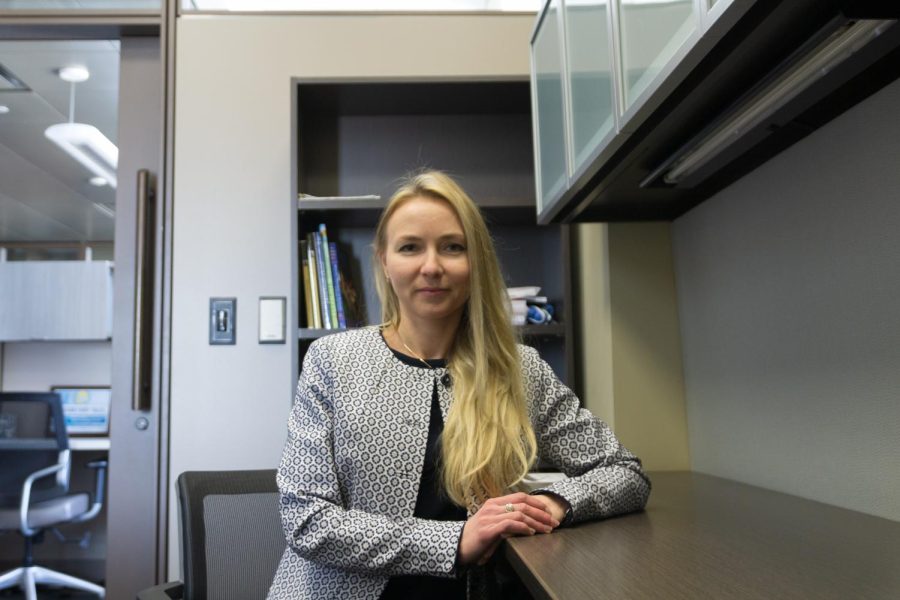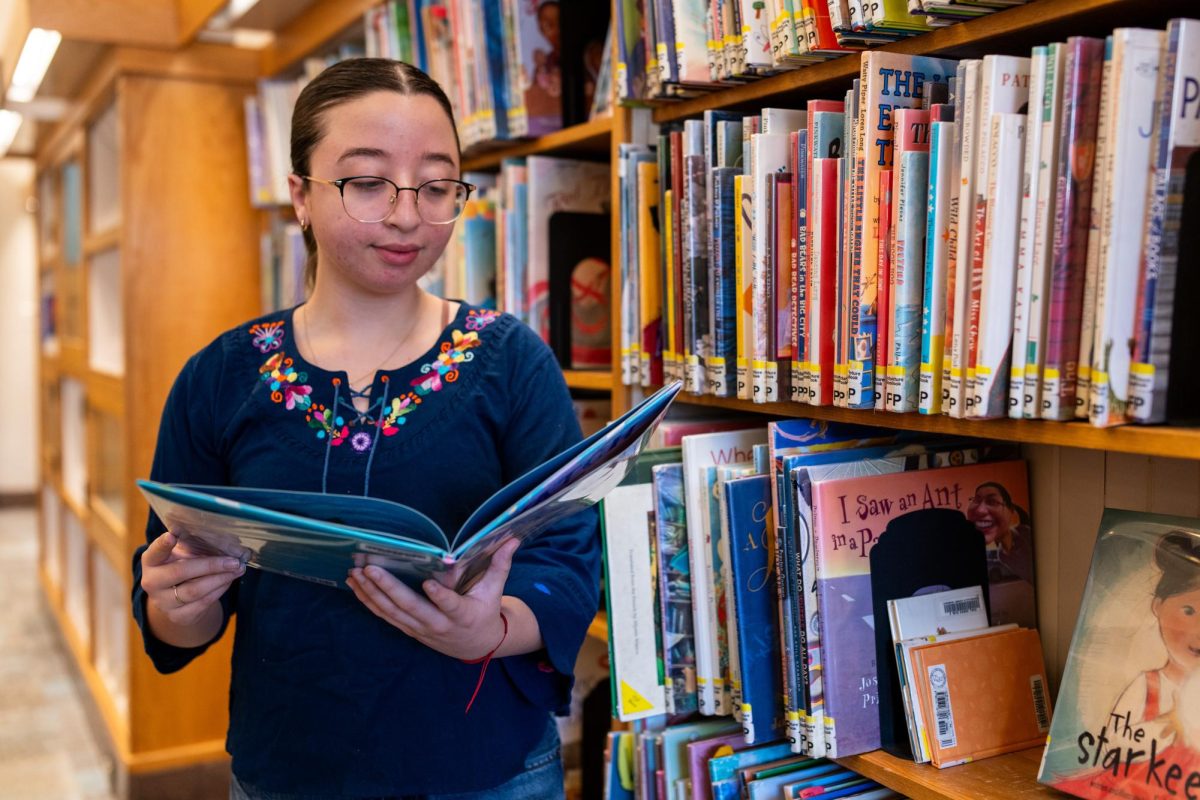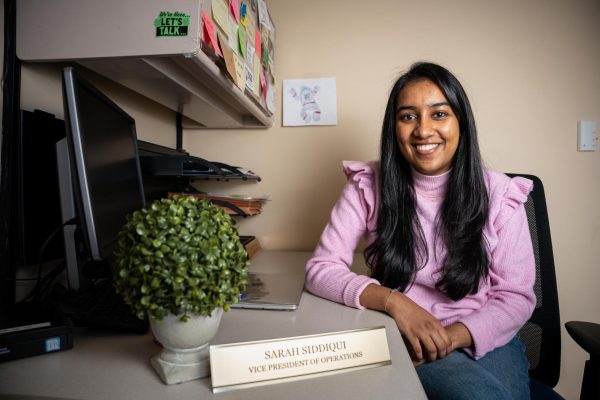Pitt’s Slavic Department explains history behind Russia-Ukraine war
John Blair | Senior Staff Photographer
Tetyana Shlikhar, visiting lecturer and Russian major undergraduate adviser, sits in her office on Monday.
March 17, 2022
When Russian missiles began ravaging multiple cities throughout Ukraine, Tetyana Shlikhar’s friends back home desperately sought out safety. Some were able to flee the country, but others remain living in fear in the now war-torn nation.
“They didn’t know where to go, so they just crossed the border,” said Shlikhar, the Russian major undergraduate advisor and a visiting lecturer.
The reasoning behind Russia’s recent invasion of Ukraine lies in the two nations’ long and complicated history. Professors from Pitt’s Slavic department and Center for Russian, East European and Eurasian studies help to provide a closer look at what led up to and caused this war.
A reporter connected Shlikhar’s friend with a Polish woman on Facebook who helped her cross the border and provided shelter for a few days until they were able to meet up with relatives in France. Poland quickly became the number one location for Ukrainians to find refuge, but not everyone is allowed to or wants to leave Ukraine.
Shlikhar said men — specifically male citizens ages 18-60 — are not currently allowed to leave the country. Not wanting to break up their families and leave their husbands, some of Shlikhar’s friends decided not to travel abroad. Others couldn’t leave because they simply did not know anyone abroad, and Shlikhar said those who stayed fled to Western Ukraine or villages outside of Kyiv.
“Villages are not safe as well, especially villages around Kyiv, they were destroyed completely and it was very devastating,” Shlikhar said. “It’s a very difficult reality.”
Trevor Erlacher, the academic advisor of the Center for Russian, East European and Eurasian Studies, said Russia and Ukraine have had an “asymmetrical” relationship dating back to the 17th century, when they existed as two separate states. The Russian Empire eventually assimilated what is today known as Ukraine after a series of conquests over the 18th and 19th centuries.
Erlacher said two factions existed in 19th century imperial Russia — the Russian nationalists and the Ukrainian nationalists. The conflict between these two factions was not of a violent nature — they held competing ideas regarding what the Russian empire should look like.
“On one side, there is this idea that they’re all one people, they all belong under the Czar and they all belon+g in one state,” Erlacher said. “And then on the Ukrainian side, [they believe] that there should at least be some sort of local autonomy, and that they should have equal rights within a federation of nations.”
Ukraine claimed total independence in 1918, but once World War I began, Erlacher said empires throughout Europe and Eurasia began to break apart and formed “new nation states.” This element ushered in the formation of the Soviet Union, and Ukraine was one of its founding members in 1922, according to Erlacher.
“For a time, there was a policy called Ukranization in which Ukrainian language and culture was elevated and promoted by Soviet authorities. This was a period of Ukrainian renaissance,” Erlacher said. “In the 1930s, as Stalin consolidated his power, there was a reversal of this policy and a return to what we might call Russification, which was combined with a man-made famine in 1932-33 that killed millions of Ukranians and others living in the republic.”
Erlacher said the “years of terror” that followed these events and the tragedies of World War II left a traumatic effect on the Ukrainian population. The nation finally gained independence in 1991, and Ukrainian society has been changing rapidly ever since, according to Erlacher.
He said Russia and Ukraine would not meet in violent conflict until war broke out in the Donbas region in 2014.
Shlikhar said two main factors that led to the Donbas war were the Euromaidan revolution in 2013 and the Russian annexation of Crimea in 2014. She said the Euromaidan Revolution resulted from the former Ukrainian President Yanukovych’s decision to not sign a European Union trade agreement, meaning Ukrainians had to continue to deal with Russia and “turn their backs” on Europe.
“Most Ukrainians were already Western oriented. They wanted European life and did not want the dictatorship and totalitarian regime anymore,” Shlikhar said. “They began to oppose that alliance with Russia.”
Following the collapse of the Soviet Union, Crimea became an autonomous republic of Ukraine until being annexed by Russia. Shlikhar said the annexation of Crimea was “peaceful,” but a false referendum was used to accomplish it, so Ukrainians still consider the region “an occupied territory of Ukraine.”
The Euromaidan revolution remained intact during this time, and Erlacher said reactions to the revolution were much more “hostile” in the Donbas region of Ukraine. This hostility allowed for the Russian government to form a seperatist movement and intervene directly with Russian soldiers.
Shlikhar said Ukraine is a “luscious” piece of land that Russia has always wanted to have, and as the country began to move towards Europe, President Putin saw Ukraine as a threat and started the war out of fear that Russia would permanently lose this land to Europe.
“Without Ukraine, Russia is just a country. With Ukraine, it is an empire. It has power, the Black sea,” Shlikhar said. “Ukraine is a very rich country in terms of resources. It has very fertile soil and is one of the biggest countries in Europe apart from Russia.”
The war never officially ended and has accumulated nearly 14,000 deaths over the last eight years, according to Erlacher. He said the world has ultimately forgotten about this conflict until its most recent escalation — the full fledged Russian invasion of Ukraine starting in late February.
The international community showed their condemnation of the Russian attacks by imposing sanctions and other financial restrictions against Russia. Nancy Condee, the director of the Center for Russian, East European and Eurasian Studies, said a sanction is a restriction placed on trading transactions that one country may impose on another.
“U.S. bans include restrictions on telecommunication, semiconductors, lasers, encryption security, as well as navigation, air and sea technologies,” Condee said. “Internationally, each country or cluster of member states, such as the EU, has a different profile.”
The European Union sanctioned Russia’s seven largest banks, but exempted the two largest financial institutions — Sberbank and Gazprombank — because these institutions are necessary in stabilizing EU payments for Russia’s oil and gas imports, according to Condee.
But she said the United States placed bans on both Sberbank and Gazprom because it is much less dependent on Russian natural gas and oil than EU nations.
Condee said both the U.S. and EU member states pushed to disconnect those seven Russian banks from the Society for Worldwide Interbank Financial Telecommunications. SWIFT connects more than 200 countries and territories through 11,000 financial institutions, according to Condee, and she said disconnecting the Russian banks from the system will prevent other SWIFT institutions from receiving their payment messages.
Condee said the sanctions and restrictions being placed on Russia affect the daily lives of its citizens in “inconsistent and unpredictable ways,” and are expected to affect the wealthy most severely.
“The ‘liberal intelligentsia’ — though ‘liberal’ has different associations in Russian — is appalled and nauseated at the invasion and its consequences. It confirms the impossibility of any positive association with their state and its ideology,” Condee said. “They see no good outcome. Restrictions, therefore, are merely confirmation of this hopelessness.”








